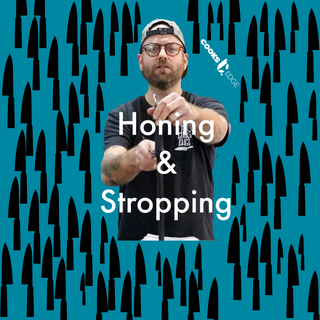We are now at the final stage before you can begin to use your freshly sharpened knife! These last steps, honing and stropping, are very important for the longevity of your sharp edge.
All About Honing:
Metal is malleable which means you can get microscopic bends in the edge of your knife during use. Honing will realign the edge to ensure you get the best cutting performance from your knife. You should hone your knife after you finish sharpening on whetstones as well as before any food prep.
- At The Cook's Edge we recommend the use of a ceramic honing rod to do this step. We avoid steel or diamond rods as they are too rough and can damage your knife.
- For Western knives that are made with softer steel, we recommend a coarse honing rod.
- For Japanese knives that are made from harder steel, a fine honing rod works best.
- Honing isn't the same as sharpening since it doesn't remove any metal from the knife. Your knife should feel sharper after honing because the edge will be realigned and will cut through food more efficiently. If you feel like your knife is still dull after honing, it is probably time to sharpen on whetstones again.
How to Hone Your Knife:
Starting at the heel of your knife, run the knife down the rod using light pressure. Repeat this process 4-6 times per side.
All About Stropping:
This last step polishes the edge of the knife, removing any of the excess metal left over from the knife sharpening process. Stropping will make the difference between a sharp knife and a VERY sharp knife.
- Although other things can be used for stropping a knife, the most common material is leather. A double-sided leather strop is a good investment for any knife sharpener.
- At The Cook's Edge, we use the suede side of our leather strop to remove any of the remaining burr and the smooth side for the final polish.
- Although a leather strop can be used on its own, the use of a compound will help to further polish the edge. We recommend a chromium oxide compound be applied very sparingly to the suede side of the leather strop.
How to Use a Leather Strop:
When using a leather strop you want to make sure you don't push the cutting edge of the knife into the leather. Always move the knife up the strop with the cutting edge trailing. Make 4-6 passes over the leather strop on each side of your knife.
*Knife Sharpening Tip* Do not wait for your knife to get extremely dull before sharpening. This will require much more time and you will have to remove more of the steel in order to get it sharp again. You should be sharpening your knives frequently, at the first sign of them becoming dull.
The importance of using a sharp knife:
- It is safer than using a dull knife as you do not need to use as much force and your knife is less prone to slipping.
- Your food will look and taste better. A dull knife rips through food causing you to lose the tasty juices. Vegetables, meat and herbs will all taste better when cut with a sharp knife.
- Meal prep will definitely be more fun and less time-consuming. Why not make cooking a more enjoyable experience?
Okay, so now you have learned the skill of knife sharpening and it is time to get cooking! Enjoy!


 is here! Shop now, pay later in 4 easy installments
is here! Shop now, pay later in 4 easy installments